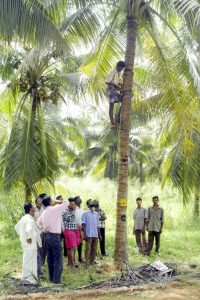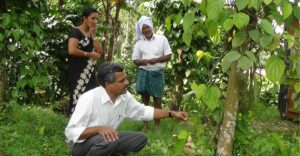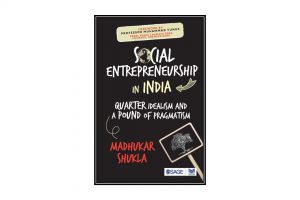Edited by: Thamban C, Jaganathan D, Kalavathi S, Anithakumari P, Chandran KP, Jayasekhar S (2016)
Published by: ICAR-Central Plantation Crops Research Institute, Kasaragod, Kerala, India
Pages: 269
Plantation crops play a vital role in the Indian economy, by way of their contribution to agricultural exports, income generation, and poverty reduction. This is especially so in states such as Kerala, Karnataka, Tamil Nadu, Assam, and West Bengal, which have significantly more area under plantation crops (coconut, arecanut, oil palm, cashew, tea, coffee, rubber, cocoa and spices). However, the plantation sector is teetering under issues such as climate change, increasing labour and input costs, and fluctuating output prices. Enhancing productivity, reducing the cost of production, and value addition are critical to address some of these challenges and Extension and Advisory Services (EAS) need to support farmers in these aspects.
This book provides a fascinating glimpse into the innovative extension approaches being deployed in the Indian plantation sector. These include: mobilising producers into groups for collective action, participatory decentralized initiatives for production, and distribution of elite planting materials, and innovative capacity building programs including the use of ICTs. The strengths and weakness of each of these approaches in attaining sustainable development of the Indian plantation sector are also discussed.
The book narrates the success story of Subicsha – a role model for a coconut-based microenterprise led by women SHGs that has survived stiff competition from corporate giants. Subicsha is a federation of tiny enterprises functioning under a single umbrella as a producer company. Another case is from the natural rubber sector. The Rubber Producer Societies (RPS) serves as an effective extension arm of the Rubber Board, Government of India. The smallholder empowerment approach adopting cluster-based and community-driven development through the formation and institutionalization of RPSs was a milestone in the progress and development of the natural rubber sector.
 Another innovative extension initiative discussed in this book is about the ‘Friends of Coconut Trees’, which has come out of the capacity development programme for rural youth that points to sustainable development of the coconut sector. The programme developed a professional group of youth for harvesting and plant protection operations in coconut. Some of the other cases discussed in the book include: participatory technology transfer in arecanut-based cropping system to promote the concept of arecanut-based multi species cropping system to increase the productivity and profitability of farming from unit area; interactive video conferencing – an ICT tool for organizing research-extension-farmer interface programs in plantation crops. It is effectively utilised for scheduling and implementing interface programmes at regular intervals involving various stakeholders, including researchers, extension personnel, farmers and entrepreneurs.
Another innovative extension initiative discussed in this book is about the ‘Friends of Coconut Trees’, which has come out of the capacity development programme for rural youth that points to sustainable development of the coconut sector. The programme developed a professional group of youth for harvesting and plant protection operations in coconut. Some of the other cases discussed in the book include: participatory technology transfer in arecanut-based cropping system to promote the concept of arecanut-based multi species cropping system to increase the productivity and profitability of farming from unit area; interactive video conferencing – an ICT tool for organizing research-extension-farmer interface programs in plantation crops. It is effectively utilised for scheduling and implementing interface programmes at regular intervals involving various stakeholders, including researchers, extension personnel, farmers and entrepreneurs.
The book articulates the need for a change in perspective on the role and contribution of extension services in the plantation sector. Though the conventional notion of extension as an add-on of the knowledge/technology generation process has changed globally, in India, many still consider it as a technology transfer agency liaising between research and farmers. In the plantation sector, extension personnel have been using a wide range of extension approaches such as mobilising farmers, provision of one-on-one advisory support at the field level, organising demonstrations, training and workshops, holding informal group discussions, using written material (leaflets, pamphlets, etc.), and ICTs (mobile advisory, SMS, video conferencing). The emerging trend in the plantation sector extension service delivery is of the increased use of participatory activities along with the research system involving the stakeholders.
Compared to conventional top-down extension approaches, the innovative extension approaches in the plantation sector focus on multi-disciplinary, collaborative and participatory technology development involving assessment and refinement of new technologies; and the use of participatory rural appraisal techniques for identification of problems in plantation, and development of appropriate action plans. Another shift is in terms of using farmer field schools based on the concepts and principles of people-centred learning, and provision of handholding support to help producers come together to establish farmer producers organisations.
The low impact of extension work and poor feedback available to research systems on performance of newly introduced technologies has adversely affected the professional credibility of extension. Extension professionals have started using ICTs to address some of these challenges. The development of extension teaching materials has seen a seismic change with the use of innovative concepts such as voice-based e-extension systems, mobile-linked extension services, enhanced use of multimedia, etc. These are elaborated upon in this book. The book also highlights the importance of documenting and using indigenous knowledge as some of these can help in reducing costs, as well as limit the use of costly external inputs.
Participation of stakeholders from all sectors in all activities – right from the strategic planning up to marketing/manufacturing – is crucial for the progress and development of any industry. Even after glorifying the success of innovative extension approaches in the case of plantation crops. The book mentions that the sector so far has not effectively utilised the possible linkages among various research, development, and extension agencies for enhancing production and marketing efficiencies. Further, various challenges faced by the sector in the era of free trade such as price instability, lack of appropriate technologies for small land holdings, lack of congenial government policies, limited product diversification, etc., need to be investigated for achieving inclusive growth and ensuring sustainability of the plantation economy.
 Most of the experiences shared in this book are from Kerala State, which has almost 40 percent of its cultivable land under plantation crops. Inclusion of cases from other states could have added more value to this publication. The book lacks an executive summary and a way forward section synthesising the major findings. However, these are minor limitations given the wealth of information available in this book. Each chapter is well-outlined, providing background information, a substantive summary, description of detailed models, comparison charts and tables, discussions and ample references.
Most of the experiences shared in this book are from Kerala State, which has almost 40 percent of its cultivable land under plantation crops. Inclusion of cases from other states could have added more value to this publication. The book lacks an executive summary and a way forward section synthesising the major findings. However, these are minor limitations given the wealth of information available in this book. Each chapter is well-outlined, providing background information, a substantive summary, description of detailed models, comparison charts and tables, discussions and ample references.
Beyond extension professionals, the book can be of interest to stakeholders from other sectors, including those engaged in research, education, industry, marketing and processing. Ideally this could be an extremely useful text for the university classroom and a valuable in-service guide for employees who wish to know more about alternative extension approaches in the plantation sector. It also serves as a handbook for Extension officers/scientists/SMS who not only want to brush up on what they already know but also want to learn more about innovative extension methods/approaches.
Onima VT

Dr Onima VT (onimavt@gmail.com), Research Officer, Centre for Research on Innovation and Science Policy (CRISP), Hyderabad, India.





Nice write up regarding Innovative Extension Approaches for Plantation Crops.